Peep shows and poverty… the writer/director of Import/Export discusses his epic undertaking.
How long did it take you to make Import/Export?
Almost four years. I don’t simply write a screenplay and then execute it. I take it into reality. Where could it take place? Who could play these parts? These things cause changes in the story and lead it to greater depths. Some things are planned. Some things are encountered during the shoot.
LWLies: How do you feel, having spent four years on one film?
Relieved! Because it’s a long journey and it can be too long. I can’t know that, for example, there’ll be a shortfall in the funding or that we’ll have to wait a year for the next winter to start filming again, or that it will take months to get permission to shoot in the geriatric wards.
How much footage did you shoot?
A lot! And I cut a film out of it. It’s a long process and it leads to new things – like the end, which wasn’t planned, and the structure, which comes out of the material and working with the material.
Did you actually have fun?
I enjoy writing; it’s really not a struggle for me. But shooting is more exciting, dealing with people, translating ideas into reality. But it’s the editing process that’s a torture as far as I’m concerned.
Was the editing a nightmare?
During editing, it got down to five or six hours. And then at three and a half hours it could have worked. Maybe if I am unemployed one day, I can go back and make the longer version.
Do you have a scene you’re most proud of?
No. Not a single scene, but I’m very proud of the success we had in the geriatric hospital. The combination of a real situation and a fictional framework. And that what came out was so in focus. That’s something that can only develop over a long period of time. It’s not something you can just create.
Do you think it was wrong to use real geriatric patients as actors?
The point is how you do it not what you do. No one can tell you what you should or shouldn’t film. I’m responsible for filming the people without them losing their dignity, and I believe I did that.
Did it feel like a moral tightrope?
Not for me, certainly. I know I’ve represented them properly. Some people are shocked with what they see. Because they see how people look when they’re old and they’re dying. But the alternative would be to think that these people are not worth showing.
You famously use non-professionals. How did you find your lead actress?
We looked across the Ukraine. She’d never been to Austria before – she had to learn German for the film – which is what I wanted. She’s a real talent. She could have stayed in the West but she decided to go back. She works in a local children’s theatre.
What’s the secret to coaxing out a great performance?
My secret recipe is a question I’m often asked! I think it’s extremely important to find the right person, and then explaining over a long period of time what I want. Basically you want to convince them they can do it before you start working on the script.
Will you have a holiday now?
No pauses! I’m doing two films now. The first is a small film called Keller In The Cellar. It’s about the relationship of the Austrians to their cellars.
And the second?
It tells the story of three women on holiday: two sisters and the daughter of one of the two women. The first woman goes to Africa to participate in the sex tourist trade. The other sister indulges her religious fanaticism. And the young girl becomes overweight and goes to a diet camp where she falls hopelessly and unhappily in love.
Can we assume that neither of these films will be comedies?
My films are also always comedies. You can always laugh!
Read the original article at Little White Lies.










